This article is about the film. For other uses, see Atlantis.
- “...in a single day and night of misfortune, the island of Atlantis disappeared into the depths of the sea. -Plato, 360 B.C.”
- ―Opening text
Atlantis: The Lost Empire is a 2001 American animated film created by Walt Disney Feature Animation—the first science fiction film in the Animated Canon and the 41st overall. Written by Tab Murphy, directed by Gary Trousdale and Kirk Wise, and produced by Don Hahn, the film features an ensemble cast with the voices of Michael J. Fox, Cree Summer, James Garner, Leonard Nimoy, Don Novello, and Jim Varney in his final role before his death. Set in 1914, the film tells the story of a young man who gains possession of a sacred book, which he believes will guide him and a crew of adventurers to the lost city of Atlantis.
Development of the film began after production had finished on The Hunchback of Notre Dame (1996). Instead of another musical, the production team decided to do an action-adventure film inspired by the works of Jules Verne. Atlantis was notable for adapting the distinctive visual style of comic book creator Mike Mignola. At the time of its release, the film had made greater use of computer-generated imagery (CGI) than any of Disney's previous animated features; it remains one of the few to have been shot in anamorphic format. Linguist Marc Okrand created a language specifically for use in Atlantis, while James Newton Howard provided the score. The film was released at a time when audience interest in animated films was shifting away from hand-drawn animation toward films with full CGI.
Atlantis: The Lost Empire premiered at the El Capitan Theatre in Hollywood, California on June 3, 2001, and went into general release on June 15. Distributed by Walt Disney Pictures, Atlantis performed modestly at the box office. Budgeted at $100 million, the film grossed over $186 million worldwide, $84 million of which was earned in North America. This was likely due to the fact that it had to compete with Lara Croft: Tomb Raider and Shrek (which involved former Disney worker Jeffery Katzenberg). Due to the film's poorer-than-expected box-office performance, Disney quietly canceled both a spin-off television series and an underwater attraction at its Disneyland theme park. Some critics praised it as a unique departure from typical Disney animated features, while others disliked it due to the unclear target audience and absence of songs. Atlantis was nominated for a number of awards, including seven Annie Awards, and won Best Sound Editing at the 2002 Golden Reel Awards. The film was released on VHS and DVD on January 29, 2002, with the Blu-ray released on June 11, 2013. Atlantis is considered to be a cult favorite, due in part to Mignola's unique artistic influence. A direct-to-video sequel, Atlantis: Milo's Return, was released in 2003.
Plot[]
In 6,800 BC, an accidental energy discharge caused a titanic tsunami that threatens to destroy the capital city of Atlantis. A huge azure light floating above the city calls upon the Queen and pulls her up so that they would be bonded in order to save the city. Her young daughter, Princess Kidagakash, watches in tears before her father, King Kashekim Nedakh, runs to her and covers her eyes. The power of the crystal creates a protective barrier around the center of the city, keeping it from being destroyed by the tsunami. However, it also results in the city being buried beneath the subsiding waters.
In 1914, Milo James Thatch is preparing his presentation to his employers at the Smithsonian Institution in Washington, D.C. on the lost continent of Atlantis. He notes that he believes there is a power source that the Atlanteans used and that it could still be hidden within the sunken city. He reasons that there is a book called the Shepherd's Journal that has been seen throughout history that would contain a detailed road map to the city and believes that the book is in Iceland. During the presentation, he gets a call to fix the boilers, revealing that he is not an employed linguist or cartographer, but rather the janitor. The Institution's board then attempts to deceitfully back out. Milo chases after them and manages to corner Mr. Fenton Harcourt, who completely dismisses the existence of Atlantis as myth. Even when Milo threatens to quit, Harcourt notes that the search for Atlantis is a career killer, which is what happened to Milo's late grandfather Thaddeus Thatch.

Whitmore convinces Milo to follow in his late grandfather's footsteps.
Milo returns home disheartened, only to suddenly meet a woman named Helga Sinclair. She tells him that she is there on behalf of her employer with a proposition. When Milo asks who her employer is, she instead drives him to the estate of Preston Whitmore. Upon arriving in Whitmore's private study, Milo discovers that Whitmore was friends with his grandfather. He finds Whitmore in the middle of completing a yoga session before pointing out a parcel addressed to Milo from his late grandfather. Milo opens the parcel to find, to his disbelief, the Shepherd's Journal. Whitmore explains that he is fulfilling a bet he made to Thaddeus by financing the expedition, though it is clear that he is willing to do it regardless because of his friendship with him. Whitmore adds that everything is set and all they need is someone who can read the book, which is Milo. Without much hesitation, Milo agrees to participate.
In preparation for the expedition to begin, Milo discovers that Helga is more than just Whitmore's personal assistant as she is the expedition's second-in-command. He also has run-ins with the elderly cook Jebidiah "Cookie" Farnsworth and demolitions expert Vincenzo "Vinny" Santorini before Whitmore introduces him to the expedition's commanding officer Commander Lyle Rourke. Announcements are heard from elderly radio operator Wilhelmina Packard, with the last being for final boarding on the advanced submarine ship the Ulysses. After Milo waves Whitmore good-bye, the submarine is launched.

Milo realizes that the Leviathan is actually a machine.
Milo continues to meet some more of the expedition crew, such as French geologist Gaetan "Mole" Molière, chief medic Doctor Joshua Sweet, and teenage mechanic Audrey Ramirez before conducting a briefing of where to find the entrance leading them to Atlantis. Suddenly, they are attacked by a giant mechanical Leviathan. Despite best efforts to defend themselves against the beast, all hands are forced to abandon ship after it sustains too much damage. The path to the entrance is located and all surviving ships follow with the Leviathan chasing after them until it can no longer do so. Upon reaching an air-pocket, only a small fraction of the crew have survived.
The remainder of the expedition continues forward, with Milo leading the way through his translating of the directions in the Shepherd's Journal. Tricks are played upon him by other crew members until they finally take him in during a stop for rest. Milo comments that the Shepherd's Journal may be missing a page, but the others get him to ease off the book for a moment. He comments that he is just so excited about being on such an adventure, though the others note they're mainly in it for the money. After opening up about himself, Milo hears about Sweet, Audrey, and Vinny, though he is warned by Sweet not to learn about Mole's story. As everyone sleeps, a figure that has been watching the expedition digs through Milo's possessions until it is run off by Milo awakening to use the bathroom. While he is unbuckling his belt, he points the flashlight at what appears to be a lamp. The light causes a wave of fireflies to attack the camp. Most survive the attack and try to escape into a cave, but the amount of weight of their vehicles causes the bridge to collapse.

The Atlanteans can speak other languages as theirs was the root source.
Most everyone survives the collapse. Examination of their position finds them, according to Mole, placed in the bowels of a volcano that is dormant and will erupt if disturbed by a powerful enough force. Further examination finds that there is a possible escape route through what appears to be the top of the volcano when everyone realizes that Milo is missing. Milo awakens to find himself surrounded by strange figures until one of them pulls off its mask, revealing a human woman behind. She uses a crystal hanging around her neck to completely heal a cut on his shoulder before taking off. Milo follows with the expedition catching up and in the process they find themselves looking at Atlantis, alive and thriving. The figures discovered to be Atlanteans return with Milo being able to communicate with them before they realize the Atlanteans can speak any language as theirs is the root source for all others. The woman, revealed to be Princess Kidagakash, agrees to take them to meet her father the King. Along the way, Helga expresses to Rourke hesitation about the mission since there are people alive. Rourke, on the other hand, feels it doesn't change the objective of their mission.
Milo, Rourke, and Helga are brought before the blind King Kashekim by Kida. Only Milo is able to understand through the interaction between the father and daughter that outsiders are not welcome and would have originally been killed on sight. Kashekim then speaks English, recognizing why they're really down there, and tells them to leave. Rourke manages to talk him into letting the crew stay for one night so they can rest and resupply. After Milo, Rourke, and Helga leave, Kida and her father continue to argue with Kashekim, believing the outsiders can help them rediscover their dying culture, while Kashekim firmly states their way of life is being preserved.
Meanwhile, the crew still wishes to get some answers about what's going on and what to do next. They decide to have Milo speak with Kida. Milo has no trouble talking to Kida as she ends up the one to engage in the conversation.
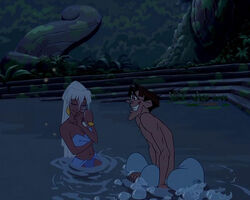
Milo flusters repeatedly when Kida suggests they swim.
Milo and Kida start to get to know one another as well as understand where each came from. Kida tells of her witnessing the great flood, which shocks Milo since it makes her much older than she appears. Milo attempts to find out about the power source he is looking for but gets sidetracked with another shock when it is realized that no one in Atlantis can read the written Atlantean language. Through Milo, he and Kida are able to figure out how to activate one of the Ketaks before they tour the city. The tour is really Kida leading Milo towards a deep pond underneath which a great number of written information is found. Milo and Kida swim around with Kida's crystal providing light needed for Milo to read. Milo discovers that the power source he's been looking for is the very crystal that took Kida's mother and it is the reason Atlantis is still able to thrive alive. However, the location of the Heart of Atlantis is unknown and Milo suspects the missing page contains its whereabouts.
When Milo and Kida surface, they are surprised to find Rourke leading the rest of the expedition to begin a more forceful manner in finding the Heart of Atlantis, the power source to both the city and its people, horrifying Milo that even Sweet, Audrey, and the others are in on it. Rourke reveals to have possession of the missing page and forces Milo to translate by pointing a gun at Kida after he initially refuses since the crystal is needed to keep Atlantis alive. They end up in the King's chamber as the page notes that the Heart of Atlantis "lies where the eyes of the King can see". Kashekim refuses to elaborate on the riddle, even after being punched and under threat of execution, much to the horror of the others and even Sweet, who already turns against Rourke for his actions. Just before pulling the trigger, Rourke is able to figure out the riddle that the middle of the room leads to the chamber containing the crystal. Rourke and Helga force Milo and Kida to join them as they descend into the chamber to find the Heart of Atlantis with stone effigies of the past kings orbiting it. While Rourke and Milo argue about how to retrieve the crystal, which is levitating in the air, the crystal calls to Kida and she is soon infused with the crystal. By warning of Milo, they do not touch her while Rourke's men place her in a container.
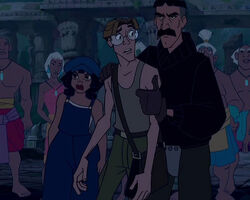
Milo's speech convinces some of the others to side against Rourke.
Just before Rourke and the rest of the expedition make off, Milo sarcastically congratulates the crew by saying that their actions will kill the Atlanteans. Rourke punches hard on Milo and leaves him to be forgotten from the world along with a cracked frame of him & Thaddeus. Feeling that it wasn't right for what they're doing (along with how much Milo meant to them), Audrey, Vinny, Mole, Cookie, and Packard decide to side with Milo, not wanting the death of innocent lives to be on their conscience. The pleas fall on deaf ears with Rourke, who destroys the wooden bridge to keep them from following. With the Heart of Atlantis no longer in the city to keep it powered, it places Atlantis and its civilians in danger. Milo meets with the dying King, who explains that the Heart of Atlantis calls upon one with royal blood to bond with to protect itself and the people, heaving developed a consciousness of its own. Because of his arrogance in ruling Atlantis with the crystal, it became too strong to control, and it leads to the sinking of the city and his wife being sacrificed to save them. Before he dies, he notes that the crystal needs to be returned not only to save Atlantis, but to prevent Kida from being lost by bonding with the crystal for too long. After an encouraging talk from Sweet, Milo directs everyone to a Ketak and how the crystals they possess still have enough power to activate them.
Rourke and his men blow a hole through the top of the volcano and attempt to fly out through a Gyro-Evac when Milo and the others arrive to stop them. During the battle, Vinny accidentally discovers how to discharge an energy bolt from the vehicles to counter the guns and firepower Rourke and his men possess. Milo and Vinny then distract Rourke and Helga while Sweet and Audrey try to release the container with Kida. Though Rourke and Helga drive off Sweet and Audrey, Milo crashes his Ketak into one of the balloons and causes it to slowly descend. Helga tries to lighten the load, but they are still dropping when Rourke decides to push her off. She manages to swing back on and kick Rourke around for betraying her, but Rourke catches her and throws her off for good. Milo and Rourke get into a scuffle with the balloon once again ascending, but a badly hurt Helga gets back at Rourke by firing a flare gun and destroying the main balloon, thereby causing it to descend permanently.
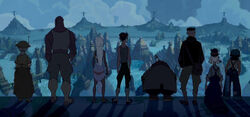
The heroes look out and survey the restored city of Atlantis.
An enraged Rourke goes after Milo with an axe, during which he breaks a glass hole from the container. Milo notices one of the glass shards has elements of the crystal and uses it to cut Rourke when he holds him up by the neck. The cut causes elements of the crystal to mix into Rourke's blood, turning him into crystal form. Nevertheless, he still attacks until a chance positioning causes Rourke to shatter after connecting with the still turning propellers of the hot air balloon. The act disconnects the container, though Milo must move it fast to prevent the hot air balloon from crashing down upon it. The crash is enough force to cause the volcano to reawaken, and Milo and the others quickly bring the container back to the city. Milo opens up the container, and Kida and the Heart of the Atlantis ascend. They awaken giant stone guardians to create a force field to prevent lava from destroying the city. With the city saved, Kida is released from the crystal and into Milo's arms.
The Atlanteans thank those who helped Milo save them, donning each of them with crystals and providing them with an acceptable pile of gold to return to the surface with. Milo is staying behind, as he and Kida have fallen in love, and he is needed to help the Atlanteans rediscover their lost culture. Back on the surface, Whitmore debriefs Vinny, Sweet, Audrey, Mole, Cookie, and Packard into rehearsing a false story about them finding nothing as well as the made-up fates of Helga, Rourke, and Milo. While going through photos Packard took, Whitmore discovers a package for him containing a picture of Thaddeus and child Milo, a crystal, and a message thanking him on behalf of the Thatches for helping them realize their dream. Back in Atlantis, Milo completes the construction of a stone effigy of Kashekim to join the other past kings orbiting the Heart of Atlantis as it once again hovers above the newly restored city.
Production[]
Development[]
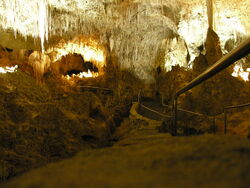
The production team visited New Mexico's Carlsbad Caverns to get a sense of the underground spaces depicted in the film.
The idea for Atlantis: The Lost Empire was conceived in October 1996 when Don Hahn, Gary Trousdale, Kirk Wise, and Tab Murphy lunched at a Mexican restaurant in Burbank, California. Having recently completed The Hunchback of Notre Dame the producer and directors wanted to keep the Hunchback crew together for another film with an Adventureland setting. Drawing inspiration from Jules Verne's A Journey to the Center of the Earth (1864), they set out to make a film which would fully explore Atlantis (compared to the brief visit depicted in Verne's novel). While primarily utilizing the Internet to research the mythology of Atlantis, the filmmakers became interested in the clairvoyant readings of Edgar Cayce and decided to incorporate some of his ideas—notably that of a mother crystal which provides power, healing, and longevity to the Atlanteans—into the story. They also visited museums and old army installations to study the technology of the early 20th century (the film's time period), and traveled 800 feet underground in New Mexico's Carlsbad Caverns to view the subterranean trails which would serve as a model for the approach to Atlantis in the film.
The filmmakers wanted to avoid the common depiction of Atlantis as "crumbled Greek columns underwater", said Wise. "From the get-go, we were committed to designing it top to bottom. Let's get the architectural style, clothing, heritage, customs, how they would sleep, and how they would speak. So we brought people on board who would help us develop those ideas." Art director David Goetz stated, "We looked at Mayan architecture, styles of ancient, unusual architecture from around the world, and the directors really liked the look of Southeast Asian architecture." The team later took ideas from other architectural forms, including Cambodian, Indian, and Tibetan works. Hahn added, "If you take and deconstruct architecture from around the world into one architectural vocabulary, that's what our Atlantis looks like."< The overall design and circular layout of Atlantis were also based on the writings of Plato, and his quote "in a single day and night of misfortune, the island of Atlantis disappeared into the depths of the sea" was influential from the beginning of production. The crew wore T-shirts which read "ATLANTIS—Fewer songs, more explosions" due to the film's plan as an action-adventure (unlike previous Disney animated features, which were musicals).
Language[]

The Atlantean letter A, created by artist John Emerson. Kirk Wise noted that its design was a treasure map showing the path to the crystal, "The Heart of Atlantis".
- Main article: Atlantean language
Marc Okrand, who developed the Klingon language for the Star Trek films, was hired to devise the Atlantean language for Atlantis: The Lost Empire. Guided by the directors' initial concept for it to be a "mother language", Okrand employed an Indo-European word stock with its own grammatical structure. He would change the words if they began to sound too much like an actual, spoken language. The written language was boustrophedon: designed to be read left-to-right on the first line, then right-to-left on the second, continuing in a zigzag pattern to simulate water flow.
Writing[]
Joss Whedon was the first writer to be involved with the film, but soon left to work on other Disney projects. Tab Murphy completed the screenplay, stating that the time from initially discussing the story to producing a script that satisfied the film crew was "about three to four months". The initial draft was 155 pages, much longer than a typical Disney film script (which usually runs 90 pages). When the first two acts were timed at 120 minutes, the directors cut characters and sequences and focused more on Milo. Murphy said that he created the centuries-old Shepherd's Journal because he needed a map for the characters to follow throughout their journey. A revised version of the script eliminated the trials encountered by the explorers as they navigated the underground caves to Atlantis. This gave the film a faster pace because Atlantis is discovered earlier in the story.
The character of Milo Thatch was originally supposed to be a descendant of Edward Teach, otherwise known as Blackbeard the pirate. The directors later related him to an explorer so he would discover his inner talent for exploration. The character of Molière was originally intended to be "professorial" but Chris Ure, a story artist, changed the concept to that of a "horrible little burrowing creature with a wacky coat and strange headgear with extending eyeballs", said Wise. Don Hahn pointed out that the absence of songs presented a challenge for a team accustomed to animating musicals, as solely action scenes would have to carry the film. Kirk Wise said it gave the team an opportunity for more on-screen character development: "We had more screen time available to do a scene like where Milo and the explorers are camping out and learning about one another's histories. An entire sequence is devoted to having dinner and going to bed. That is not typically something we would have the luxury of doing."
Hahn stated that the first animated sequence completed during production was the film's prolog. The original version featured a Viking war party using The Shepherd's Journal to find Atlantis and being swiftly dispatched by the Leviathan. Near the end of production, story supervisor Jon Sanford told the directors that he felt this prolog did not give viewers enough emotional involvement with the Atlanteans. Despite knowing that the Viking prolog was finished and it would cost additional time and money to alter the scene, the directors agreed with Sanford. Trousdale went home and completed the storyboards later that evening. The opening was replaced by a sequence depicting the destruction of Atlantis, which introduced the film from the perspective of the Atlanteans and Princess Kida. The Viking prolog is included as an extra feature on the DVD release.
Animation[]
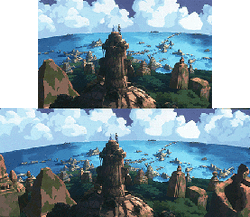
For comparison, the top image (panoramic view of Atlantis) is cropped to Disney's standard aspect ratio (1.66:1); bottom image was seen in the film (2.35:1).
At the peak of its production, 350 animators, artists, and technicians were working on Atlantis at all three Disney animation studios: Burbank, California, Orlando, Florida, and Paris, France. The film was one of the few Disney animated features produced and shot in 70mm anamorphic format. The directors felt that a wide-screen image was crucial, as a nostalgic reference to old action-adventure films presented in the Cinemascope format (2.35:1), noting Raiders of the Lost Ark as an inspiration. Because switching to the format would require animation desks and equipment designed for widescreen to be purchased, Disney executives were at first reluctant to the idea. The production team found a simple solution by drawing within a smaller frame on the same paper and equipment used for standard aspect ratio (1.66:1) Disney-animated films. Layout supervisor Ed Ghertner wrote a guide to the wide-screen format for use by the layout artists and mentioned that one advantage of wide-screen was that he could keep characters in scenes longer because of additional space to walk within the frame. Wise drew further inspiration for the format from filmmakers David Lean and Akira Kurosawa.
The film's visual style was strongly based upon that of Mike Mignola, the comic book artist behind Hellboy. Mignola was one of four production designers (along with Matt Codd, Jim Martin, and Ricardo Delgado) hired by the Disney studio for the film. Accordingly, he provided style guides, preliminary character and background designs, and story ideas. "Mignola's graphic, angular style was a key influence on the characters' 'look'," stated Wise. Mignola was surprised when first contacted by the studio to work on Atlantis. His artistic influence on the film would later contribute to a cult following.
The final pull-out scene of the movie, immediately before the end-title card, was described by the directors as the most difficult scene in the history of Disney animation. They said that the pullout attempt on their prior film, The Hunchback of Notre Dame, "struggled" and "lacked depth"; however, after making advances in the process of multiplaning, they tried the technique again in Atlantis. The scene begins with one 16-inch piece of paper showing a close-up of Milo and Kida. As the camera pulls away from them to reveal the newly restored Atlantis, it reaches the equivalent of an 18,000-inch piece of paper composed of many individual pieces of paper (24 inches or smaller). Each piece was carefully drawn and combined with animated vehicles simultaneously flying across the scene to make the viewer see a complete, integrated image.
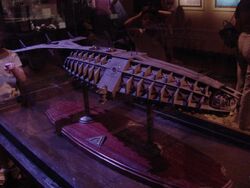
Scale model of Ulysses submarine by Greg Aronowitz, used by digital animators as reference during production.
At the time of its release, Atlantis: The Lost Empire was notable for using more computer-generated imagery (CGI) than any other Disney-animated feature. To increase productivity, the directors had the digital artists work with the traditional animators throughout the production. Several important scenes required heavy use of digital animation: the Leviathan, the Ulysses submarine and sub-pods, the Heart of Atlantis, and the Stone Giants. After Matt Codd and Jim Martin designed the Ulysses on paper, Greg Aronowitz was hired to build a scale model of the submarine to be used as a reference for drawing the 3D Ulysses. The final film included 362 digital-effects shots, and computer programs were used to seamlessly join the 2D and 3D artwork. One scene that took advantage of this was the "sub-drop" scene, where the 3D Ulysses was dropped from its docking bay into the water. As the camera floated toward it, a 2D Milo was drawn to appear inside, tracking the camera. The crew noted that it was challenging to keep the audience from noticing the difference between the 2D and 3D drawings when they were merged. The digital production also gave the directors a unique "virtual camera" for complicated shots within the film. This camera moved through a digital wire-frame set with the ability to operate in the z-plane; the background and details were later hand-drawn over the wire-frames. This was used in the opening flight scene through Atlantis and the submarine chase through the undersea cavern with the Leviathan in pursuit.
Music and sound[]
Since the film would not feature any musical interludes, the directors hired James Newton Howard to compose the score. Approaching it as a live-action film, Howard decided to have different musical themes for the cultures of the surface world and Atlantis. In the case of Atlantis, Howard chose Indonesian orchestral sound incorporating chimes, bells, and gongs. The directors told Howard that the film would have a number of key scenes without dialogue; the score would need to convey emotionally what the viewer was seeing on screen.
Gary Rydstrom and his team at Skywalker Sound were hired for the film's sound production. Like Howard, Rydstrom employed different sounds for the two cultures. Focusing on the machine and mechanical sounds of the early industrial era for the explorers, he felt that the Atlanteans should have a "more organic" sound utilizing ceramics and pottery. The sound made by the Atlantean flying-fish vehicles posed a particular challenge. Rydstrom revealed that he was sitting at the side of a highway recording one day when a semi-truck drove by at high speed. When the recording was sped up on his computer he felt it sounded very organic, and that is what is heard within the film. Rydstrom created the harmonic chiming of the Heart of Atlantis by rubbing his finger along the edge of a champagne flute, and the sound of sub-pods moving through water with a water pick.
Release[]
Promotion[]
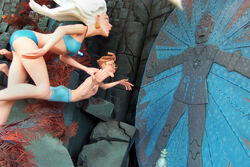
Atlantis was promoted at Disneyland with models of the characters Kida and Milo displayed on Main Street.
Atlantis was among Disney's first major attempts to utilize internet marketing. The film was promoted through Kellogg's, which created a website with mini-games and a movie-based video game giveaway for UPC labels from specially marked packages of Atlantis breakfast cereal. The film was one of Disney's first marketing attempts through mobile network operators and allowed users to download games based on the film. McDonald's (which had an exclusive licensing agreement on all Disney releases) promoted the film with Happy Meal toys, food packaging, and in-store decor. The McDonald's advertising campaign involved television, radio, and print advertisements beginning on the film's release date. Frito-Lay offered free admission tickets for the film on specially marked snack packages.
Box office[]
Before the film's release, reporters speculated that it would have a difficult run due to competition from DreamWorks' Shrek (a wholly CGI feature) and Lara Croft: Tomb Raider (an action-adventure film from Paramount Pictures). Regarding the market's shift from traditional animation and competition with CGI films, Kirk Wise said, "Any traditional animator, including myself, can't help but feel a twinge. I think it always comes down to story and character, and one form won't replace the other. Just like photography didn't replace painting. But maybe I'm blind to it." Jeff Jensen of Entertainment Weekly noted that CGI films (such as Shrek) were more likely to attract the teenage demographic typically not interested in animation, and called Atlantis a "marketing and creative gamble".[1]
Atlantis: The Lost Empire had its world premiere at Disney's El Capitan Theatre in Hollywood, California on June 3, 2001[2] and a limited release in New York City and Los Angeles on June 8; a wider release followed on June 15. At the premiere, Destination: Atlantis was on display, featuring behind-the-scenes props from the film and information on the legend of Atlantis with video games, displays, laser tag, and other attractions. The Aquarium of the Pacific also loaned a variety of fish for display within the attraction.[3] With a budget of $100 million, the film opened at #2 behind Tomb Taider on its debut weekend, earning $20.3 million in 3,011 theaters.[4] The film's international release began September 20 in Australia and other markets followed suit.[5] During its 25-week theatrical run, Atlantis: The Lost Empire grossed over $186 million worldwide ($84 million from the United States and Canada). Responding to its disappointing box-office performance, Thomas Schumacher, then-president of Walt Disney Feature Animation, said, "It seemed like a good idea at the time to not do a sweet fairy tale, but we missed."[6]
Home media[]
- Main article: Atlantis: The Lost Empire (video)
Atlantis: The Lost Empire was released on VHS and DVD January 29, 2002.[7] During the first month of its home release, the film led in VHS sales and was third in VHS and DVD sales combined.[8] Sales and rentals of the VHS and DVD combined would eventually accumulate $157 million in revenue by mid-2003.[9] Both a single-disc DVD edition and a two-disc collector's edition (with bonus features) were released. The single-disc DVD gave the viewer the option of viewing the film either in its original theatrical 2.35:1 aspect ratio or a modified 1.33:1 ratio (utilizing pan and scan). Bonus features available on the DVD version included audio and visual commentary from the film team, a virtual tour of the CGI models, an Atlantean-language tutorial, an encyclopedia on the myth of Atlantis, and the deleted Viking prolog scene.[7] The two-disc collector's edition DVD contained all the single-disc features and a disc with supplemental material detailing all aspects of the film's production. The collector's edition film could only be viewed in its original theatrical ratio, and also featured an optional DTS 5.1 track. Both DVD versions, however, contained a Dolby Digital 5.1 track and were THX certified.[7][10] Disney digitally remastered and released Atlantis on Blu-ray on June 11, 2013 bundled with its sequel Atlantis: Milo's Return.[11]
Reception[]
Atlantis: The Lost Empire received mixed reviews from film critics. Review aggregator Rotten Tomatoes reports that 49% of 140 professional critics have given Atlantis: The Lost Empire a positive review, with a rating average of 5.5 out of 10.[12] The site's consensus is that "Atlantis provides a fast-paced spectacle, but stints on such things as character development and a coherent plot".[12] Metacritic assigned the film a weighted average score of 52 out of 100 based on 29 reviews from mainstream critics; this was considered "mixed or average reviews".[13] CinemaScore polls conducted during the opening weekend revealed the average grade cinema-goers gave Atlantis: The Lost Empire was an A on an A+-to-F scale.[14]
While critics had mixed reactions to the film in general, some praised it for its visuals, action-adventure elements, and its attempt to appeal to an older audience. Roger Ebert gave Atlantis three-and-half stars out of four. He praised the animation's "clean bright visual look" and the "classic energy of the comic book style", crediting this to the work of Mike Mignola. Ebert gave particular praise to the story and the final battle scene and wrote, "The story of Atlantis is rousing in an old pulp science fiction sort of way, but the climactic scene transcends the rest and stands by itself as one of the great animated action sequences."[15] In The New York Times, Elvis Mitchell gave high praise to the film, calling it "a monumental treat", and stated, "Atlantis is also one of the most eye-catching Disney cartoons since Uncle Walt institutionalized the four-fingered glove."[16] James Berardinelli, film critic for ReelViews, wrote a positive review of the film, giving it three out of four stars. He wrote, "On the whole, Atlantis offers 90 minutes of solid entertainment, once again proving that while Disney may be clueless when it comes to producing good live-action movies, they are exactly the opposite when it comes to their animated division."[17] Wesley Morris of the San Francisco Chronicle wrote positively of the film's approach for an older audience: "But just beneath the surface, Atlantis brims with adult possibility."[18]
Other critics felt that the film was mediocre in regards to its story and characters and that it failed to deliver as a non-musical to Disney's traditional audience. Owen Gleiberman of Entertainment Weekly gave the film a C+ rating, writing that the movie had "gee-whiz formulaic character" and was "the essence of craft without dream".[19] Kenneth Turan of the Los Angeles Times noted the storyline and characterizations were "old-fashioned" and the film had the retrograde look of a Saturday-morning cartoon, but these deficiencies were offset by its "brisk action" and frantic pace.[20] Todd McCarthy of Variety wrote, "Disney pushes into all-talking, no-singing, no-dancing and, in the end, no-fun animated territory."[21] Stephanie Zacharek of Salon loathed the film, specifically Disney's attempt to make the film for an adult audience, of which she wrote, "The big problem with Disney's latest animated feature, Atlantis: The Lost Empire, is that it doesn't seem geared to kids at all: It's so adult that it's massively boring."[22] Rita Kempley of The Washington Post panned the film, calling it a "new-fashioned but old-fangled hash" and wrote, "Ironically Disney had hoped to update its image with this mildly diverting adventure, yet the picture hasn't really broken away from the tried-and-true format spoofed in the far superior Shrek."[23]
Controversies[]
It has also been criticized by some viewers of the film bearing a resemblance to a famous 1990s Japanese anime television show, Nadia: The Secret of Blue Water. The similarities include character designs, story flow, the background settings, and more. The director Kirk Wise has stated he never even heard of such a show when Atlantis was in production. The similarities might be simply due to both being inspired by the Jules Verne novel Twenty Thousand Leagues Under the Sea.
Critics also saw parallels with the 1994 film Stargate. Milo's characteristics were said to resemble those of Daniel Jackson, the protagonist of Stargate and its spinoff television series Stargate SG-1 which coincidentally launched its own spinoff, titled Stargate: Atlantis.
The film has also drawn criticism for its supposed "white savior" narrative (a storytelling device in which a white hero saves an indigenous society from danger).
Overview, production notes, and sequel[]
Atlantis is notable as one of the few animated films shot in the anamorphic widescreen process. To prevent having to purchase and implement larger animation desks, longer animation paper, and so forth, the production team resorted to working within a smaller frame on the same paper and equipment used for the standard aspect ratio Disney films.
Some viewers have noted similarities between the Milo character and motion picture language consultant Dr. Marc Okrand, who developed the Atlantean language for this movie (Okrand has said that animator John Pomeroy sketched him, claiming not to know what a linguist looked or behaved like). Additionally, an interesting aspect of the film is that very few of the characters are under the age of 30, a rare component for a Disney animated feature. Also, Atlantis is the first animated Disney feature since 1995 to have a black character, Dr. Joshua Sweet, in the roster of main characters. On a side note, Atlantis was one of the last Disney films to include a smoking character, Packard, who consistently puffed a cigarette, only had a minor role.
The film was originally supposed to provide a springboard for an animated television series titled Team Atlantis, which would have detailed the further adventures of the characters from the film. However, because of its disappointing box office intake, the series was scrapped. On May 20, 2003, Disney released a direct-to-video sequel called Atlantis: Milo's Return, which consisted mostly of stories originally produced for the aborted series.
Milo Thatch, Princess Kida, Wilhemina Packard and Commander Roark were featured as guests in House of Mouse.
In addition, several video games were released for various consoles of the time, most notably the PC game Atlantis: Trial by Fire. There were two main "campaigns" the game; Search For The Journal, which events surrounded the expedition to Iceland in order to find the journal. This segment of the game places the player as one of Rourke's mercenaries (or as the game simply states "Storm Troopers") and must fight their way through various obstacles and enemies, which are called "The Keepers". The player remains in constant radio contact throughout the game, along with the voices of most of the actors in the movie. The "reward" for finding the Journal is a trailer of the movie, also, the player can pilot the Whitmore Wing, as seen in the movie, the aircraft Rourke's mercenaries would use in their attempts to fight off Milo's attack. The second "campaign" of the game Trial by Fire, takes place during the events of the movie, and the player takes on the role of Milo Thatch. The game follows the movie very closely, and the player goes from finding Atlantis to defending it. Atlantis: Trial by Fire also had a multiplayer component, which featured modes like deathmatch, CTF, and air battles. It also included a 10-minute documentary on how the movie was made.
Jim Varney (who played Cookie) died during production, and several lines near the end of the film had to be filled in by voice actor Steve Barr as his soundalike.
In a 2020 interview, Kirk Wise revealed that a sequel was being planned out at one point. It would have introduced a new villain who was described as "wearing big, scary, wool, bulky, World War I-style clothing with a frightening gas mask" and would have lead an army of mercenaries to take back Atlantis to finish Lyle Rourke's work. The twist would have been that this new villain was actually Helga Sinclair who survived her fall at the end of the first film and be brought back as a "early-20th-century cyborg".[24]
Cast[]
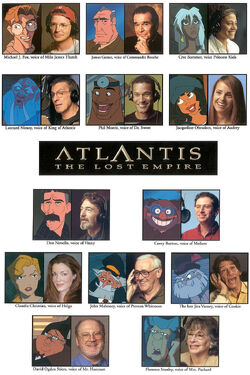
The Cast of Atlantis: The Lost Empire.
- Michael J. Fox as Milo Thatch
- Cree Summer as Kidagakash "Kida" Nedakh
- James Garner as Commander Lyle Tiberius Rourke
- Corey Burton as Gaetan Molière
- Claudia Christian as Lieutenant Helga Sinclair
- John Mahoney as Preston B. Whitmore
- Phil Morris as Doctor Joshua Sweet
- Leonard Nimoy as Kashekim Nedakh
- Don Novello as Vincenzo "Vinny" Santorini
- Jacqueline Obradors as Audrey Ramirez
- Florence Stanley as Wilhelmina Packard
- David Ogden Stiers as Fenton Q. Harcourt
- Jim Varney as Jebidiah Allardyce "Cookie" Farnsworth
- Jim Cummings as Helmsman, Atlantean Ketak Warrior, Atlantean Photographer, Businessman, Smithsonian Board Member #1
- Patrick Pinney as Smithsonian Board Member #2
- Jack Angel as Truck Driver
- Phil Proctor as Atlantean, Explorers
Additional Voices[]
- Steve Barr - Cookie (additional dialogue)
Loop Group[]
- Mickie McGowan - Female Voices
- Bob Bergen - Army Man, Squad Leader
- Rodger Bumpass - Mr Hickenbottom, Chief of the Watch
- Jennifer Darling - Atlantean Queen, Female Voices
- Paul Eiding - Sergeant
- Luck Hari - Atlantean
- Sherry Lynn - Atlantean Woman #2
- Bill Striglos - Male Explorer, Mr James
ADR Loop Group[]
- Corey Burton - Atlantean Man
- Cree Summer - Kida's Mother
Annie Awards[]
| Award | Winner/Nominee Recipient(s) | Result |
|---|---|---|
| Individual Achievement in Directing | Gary Trousdale (Director) Kirk Wise (Director) |
Nominated |
| Individual Achievement in Storyboarding | Chris Ure (Story Artist) | |
| Individual Achievement in Production Design | David Goetz (Art Director) | |
| Individual Achievement in Effects Animation | Marlon West (Effects Supervisor) | |
| Individual Achievement in Voice Acting - Female | Florence Stanley ("Mrs Packard") | |
| Individual Achievement in Voice Acting - Male | Leonard Nimoy ("King Nedakh") |
Political Film Society awards[]
It is argued that Atlantis: The Lost Empire is one of Disney's left-wing movies, hence three nominations from the Political Film Society as follows:
| Award | Notes | Result |
|---|---|---|
| Democracy | lost to Y Tu Mamá También | Nominated |
| Human Rights | lost to Focus | |
| Peace | lost to Lumumba |
Real-life references[]
Vinnie's last name, "Santorini," is also the current name of an ancient chain of volcanic islands in the Mediterranean that erupted with many times the force of Mount Vesuvius (and predated it by many centuries), devastated the Minoan civilization, and may have been an origin of the Atlantean legend. This might also explain Vinnie's profound obsession with explosives, although in the film Vinny's obsession came when there was an explosion in his family's flower shop.
Also, the weaponry is the correct time period (1914, as it says in the beginning of the film) such as: The Lee Enfield, the Lewis Gun, the Broomhandle Mauser, and a variant of the Luger. There are various models of Browning .30 Cal Machine Guns mounted on planes and other vehicles as well.
Background[]
To prepare for the production, the filmmakers visited museums and toured old army installations. They also traveled 800 feet underground in New Mexico's Carlsbad Caverns to observe the subterranean trails that would serve as the model for the approach to Atlantis in the film.
When it came to creating the look of the city of Atlantis, the filmmakers wanted to avoid the common conception of "Greek columns under the sea somewhere," says art director Dave Goetz. Instead, they modeled their Atlantis on the architecture of ancient civilizations in China, South America, and the Middle East.
Gallery[]
Trivia[]
- This is the second Disney hand-drawn animated film to feature Skywalker Sound, the first being Hercules.
- This is the third Disney hand-drawn animated film to not feature any musical numbers or any characters singing. The first two are The Black Cauldron and The Rescuers Down Under.
- If Mulan was rated PG for "action violence", this would've been the fourth Disney film to have a reason for the PG rating.
- According to animator John Pomeroy, the scene where Milo tries to impress Audrey is inspired by one from The Ghost and Mr. Chicken.
- In the Spring of 2024 a short film based on the original film called “Milo: Voyage to Atlantis” was released on YouTube. To positive reviews. Also a supposed live action adaptation trailer was released in late summer of the same year but it’s yet to be confirmed if it’s not a hoax.
References[]
- ↑ Jensen, Jeff (June 22, 2001). "High Toon: As the high-tech Shrek becomes a surprising giant-size success, is the clock ticking for traditionally animated movies?". Retrieved on September 2, 2011.
- ↑ World Premiere of Walt Disney Pictures' ATLANTIS: THE LOST EMPIRE – Update. Yahoo! (June 1, 2001). Archived from the original on June 15, 2001. Retrieved on September 22, 2011.
- ↑ Moseley, Doobie (June 15, 2001). "Destination: Atlantis at the El Capitan". LaughingPlace.com. Retrieved on September 1, 2011.
- ↑ "Atlantis: The Lost Empire Weekend Box-Office". Amazon. Retrieved on July 6, 2011.
- ↑ "Atlantis: The Lost Empire International Box-Office". Amazon. Retrieved on July 6, 2011.
- ↑ Wloszczyna, Susan (October 31, 2001). "'Toons Get Their Very Own Oscar Category". Retrieved on September 2, 2011.
- ↑ 7.0 7.1 7.2 Atlantis: The Lost Empire. Walt Disney Studios Home Entertainment. Archived from the original on June 24, 2011. Retrieved on August 8, 2011.
- ↑ McCourt, Judith (February 28, 2002). "DVD Sales Explode in January as VHS Wanes". Retrieved on August 29, 2011.
- ↑ Vancheri; Weiskind 2003 p. D–2 "Consider what happened with Atlantis: The Lost Empire. It earned $84 million at the box office and rebounded with another $157 million in DVD and VHS rentals and sales, according to Video Business."
- ↑ Rankins, Michael (May 8, 2002). Atlantis: The Lost Empire: Collector's Edition. DVD Verdict. Archived from the original on July 26, 2011. Retrieved on August 8, 2011.
- ↑ Latchem, John (March 28, 2013). "Next Wave of Disney Animated Blu-rays Coming Out June 11". Retrieved on March 29, 2012.
- ↑ 12.0 12.1 "Atlantis: The Lost Empire". Retrieved on July 16, 2011.
- ↑ "Atlantis: The Lost Empire". Retrieved on July 3, 2011.
- ↑ Drysdale, Rob (June 19, 2001). "Box Office Analysis: Lara Croft Raids the Box Office". The Trades. Retrieved on September 21, 2011. “Not surprisingly Atlantis scored a very nice set of A's from both men and women under 21 as well as men and women age 21 to 34.”
- ↑ Ebert, Roger (June 15, 2001). "Atlantis: The Lost Empire". Retrieved on August 13, 2011.
- ↑ Mitchell, Elvis (June 8, 2001). "Atlantis: the Lost Empire (2001) FILM REVIEW; Under the Sea, Damp Hakuna Matata". Retrieved on July 4, 2010.
- ↑ Berardinelli, James (June 2001). "Atlantis Review". ReelViews.net. Retrieved on July 4, 2010.
- ↑ Morris, Wesley (June 15, 2001). "Atlantis Is a Find, Disney Emphasizes Adventure over Cuteness, Romance and Song". Retrieved on August 13, 2011.
- ↑ Gleiberman, Owen (June 6, 2001). Atlantis: The Lost Empire. Archived from the original on May 27, 2008. Retrieved on June 26, 2008.
- ↑ Turan, Kenneth (July 8, 2001). "Atlantis: The Lost Empire". Retrieved on July 4, 2011.
- ↑ McCarthy, Todd (June 7, 2001). "Atlantis: The Lost Empire". Retrieved on July 4, 2011.
- ↑ Zacharek, Stephanie (June 15, 2001). "Atlantis—Disney's finally made a cartoon for grown-ups. What was wrong with the old ones they made for kids?". Retrieved on August 13, 2011.
- ↑ Kempley, Rita (June 15, 2001). "'Atlantis': That Sinking Feeling". Retrieved on March 25, 2012.
- ↑ Taylor, Drew (June 5, 2020). "Exclusive: ‘Atlantis: The Last Empire’ Co-Director Kirk Wise Reveals Details of Proposed Sequel". Collider. Retrieved on June 5, 2020.
External links[]
 Atlantis: The Lost Empire on Wikipedia
Atlantis: The Lost Empire on Wikipedia Atlantis: The Lost Empire on Disney.com
Atlantis: The Lost Empire on Disney.com- The first draft of the movie script by Tab Murphy
| v - e - d | ||||||||||||||||
|---|---|---|---|---|---|---|---|---|---|---|---|---|---|---|---|---|
|



